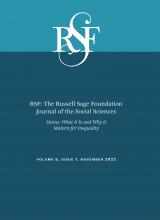Research Article
Open Access
When All Assistants Are Women, Are All Women Assistants? Gender Inequality and the Gender Composition of Support Roles
Hilary J. Holbrow
RSF: The Russell Sage Foundation Journal of the Social Sciences November 2022, 8 (7) 28-47; DOI: https://doi.org/10.7758/RSF.2022.8.7.02
Hilary J. Holbrow
aAssistant professor of Japanese politics and society at Indiana University

REFERENCES
- ↵
- Abendroth, Anja Kristin,
- Silvia Melzer,
- Alexandra Kalev, and
- Donald Tomaskovic-Devey
- ↵
- Baruch, Yehuda, and
- Brooks C. Holtom
- ↵
- Brinton, Mary C
- ↵
- Brinton, Mary C., and
- Eunmi Mun
- ↵
- ↵
- Bureau of Labor Statistics
- ↵
- Bureau of Labor Statistics
- ↵
- Cohen, Philip N., and
- Matt L. Huffman
- ↵
- Costello, Carla A
- ↵
- The Economist
- ↵
- Ely, Robin J
- ↵
- England, Paula
- ↵
- England, Paula,
- Paul Allison, and
- Yuxiao Wu
- ↵
- England, Paula,
- Andrew Levine, and
- Emma Mishel
- ↵
- Facebook Careers
- ↵
- Feintzig, Rachel
- ↵
- Goldman Sachs
- ↵
- Halldén, Karin,
- Jenny Säve-Söderbergh, and
- Åsa Rosén
- ↵
- Haynes, Suyin
- ↵
- ↵
- Huffman, Matt L.,
- Philip N. Cohen, and
- Jessica Pearlman
- ↵
- Hultin, Mia, and
- Ryszard Szulkin
- ↵
- Japan Institute for Labor Policy and Training (JILPT)
- ↵
- Japan Institute for Labor Policy and Training (JILPT)
- ↵
- Kanai, Kaoru
- ↵
- Kanter, Rosabeth M
- ↵
- Karlsson, Anette
- ↵
- Kenward, Michael G., and
- James H. Roger
- ↵
- Kenward, Michael G., and
- James H. Roger
- ↵
- Koenig, Biko
- ↵
- Koike, Kazuo
- ↵
- Kramer, Andrea S., and
- Alton B. Harris
- ↵
- Kurtulus, Fidan Ana, and
- Donald Tomaskovic-Devey
- ↵
- Laufenberg, Bella
- ↵
- Leicht, Kevin T
- ↵
- Maloney, E. K.,
- Kimberly B. Rogers, and
- Lynn Smith-Lovin
- ↵
- ↵
- McKinsey & Company
- ↵
- McNally, Danielle
- ↵
- McNeish, Daniel M., and
- Jeffery Harring
- ↵
- ↵
- Melaku, Tsedale. M
- ↵
- Ministry of Health, Labor, and Welfare
- ↵
- Ministry of Health, Labor, and Welfare
- ↵
- ↵
- Mun, Eunmi, and
- Jiwook Jung
- ↵
- Nemoto, Kumiko
- ↵
- Niselow, Tehillah, and
- Lameez Omarjee
- ↵
- Nittle, Nadra
- ↵
- Ono, Hiroshi
- ↵
- Ono, Hiroshi
- ↵
- Penner, Andrew M.,
- Harold J. Toro-Tulla, and
- Matt L. Huffman
- ↵
- Ridgeway, Cecilia L
- ↵
- Ridgeway, Cecilia L
- ↵
- Ridgeway, Cecilia L., and
- Hazel Rose Markus
- ↵
- Ridgeway, Cecilia L., and
- Lynn Smith-Lovin
- ↵
- Seeley, J. Lotus
- ↵
- Shams, Safi, and
- Donald Tomaskovic-Devey
- ↵
- Snijders, Tom A. B., and
- Roel J. Bosker
- ↵
- Srivastava, Sameer B., and
- Eliot L. Sherman
- ↵
- Stainback, Kevin,
- Sibyl Kleiner, and
- Sheryl Skaggs
- ↵
- Stainback, Kevin, and
- Soyoung Kwon
- ↵
- Stojmenovska, Dragana
- ↵
- Stojmenovska, Dragana,
- Stephanie Steinmetz, and
- Beate Volker
- ↵
- Teikoku Databank
- ↵
- Truss, Catherine,
- Kerstin Alfes,
- Amanda Shantz, and
- Amanda Rosewarne
- ↵
- Vial, Andrea C.,
- Jaime L. Napier, and
- Victoria L. Brescoll
- ↵
- Wheeler, Brian
- ↵
- Wible, Pamela
- ↵
- Williams, Joan C.,
- Erika V. Hall, and
- Katherine Philips
- ↵
- Wootton, Barbara H
- ↵
- The World Bank
- ↵
- ZipRecruiter
In this issue
When All Assistants Are Women, Are All Women Assistants? Gender Inequality and the Gender Composition of Support Roles
Hilary J. Holbrow
RSF: The Russell Sage Foundation Journal of the Social Sciences Nov 2022, 8 (7) 28-47; DOI: 10.7758/RSF.2022.8.7.02
Jump to section
Related Articles
- No related articles found.
Cited By...
- No citing articles found.





